Introduction to Endocrine-Disrupting Chemicals (EDCs)
Endocrine-Disrupting Chemicals (EDCs) are substances that can interfere with the hormonal functions at certain doses. These disruptions can cause cancerous tumors, birth defects, and other developmental disorders. Specifically, any system in the body controlled by hormones can be derailed by hormone disruptors. EDCs are found in various materials such as pesticides, metals, additives or contaminants in food, and personal care products.
Historical Context and Public Awareness
The history of EDCs dates back to the 1920s with the synthesis of the first synthetic chemical with estrogenic activity, diethylstilbestrol (DES), but it wasn’t until the 1960s that the potential hazards of EDCs came to public attention. The publication of Rachel Carson’s “Silent Spring” in 1962 was pivotal in raising public awareness about the dangers of pesticides, a class of EDCs. Since then, scientific research has expanded our understanding of EDCs and their broader impact on wildlife and human health.
Importance of Understanding EDCs
Understanding EDCs is crucial for public health. These chemicals can be found in everyday products and can accumulate in the human body, leading to an increased risk of various diseases and health issues. The potential for EDCs to affect children, even before birth, makes it imperative to understand their mechanisms of action, sources of exposure, and ways to mitigate their impact. Public education and policy changes are needed to manage and reduce exposure to these potentially harmful substances.

Do you have the most commonly used but toxic, disease bringing chemicals in your skin care? Many chemicals in skincare are hormone disruptors and make menopause symptoms worse.
Find out more…
The Ubiquity and Impact of EDCs
Common Sources of EDCs in Daily Life
Endocrine-Disrupting Chemicals (EDCs) are pervasive in modern life, infiltrating our homes, workplaces, and environments. These insidious compounds are found in a myriad of everyday items, including plastics like water bottles and food containers, personal care products such as cosmetics and shampoos, household cleaners, and even in the pesticides sprayed on the fruits and vegetables we consume. The ubiquity of EDCs is alarming, considering their potential to interfere with our body’s hormone systems.
Health Implications Across Different Life Stages
The impact of EDCs on health spans across all stages of life, from prenatal development to old age. Prenatal exposure can lead to congenital disabilities and developmental issues, while childhood and adolescence exposure can disrupt growth patterns and onset of puberty. In adults, EDCs have been linked to reproductive health problems, obesity, diabetes, and even certain cancers. The insidious nature of EDCs means that the health implications can be both immediate and latent, manifesting long after initial exposure.
Prevalence of EDCs in the Human Body
Studies have revealed the disturbing prevalence of EDCs within the human body. Biomonitoring research has detected these chemicals in blood, urine, and even breast milk, indicating that no one is immune to exposure. The presence of EDCs in pregnant women’s bodies is particularly concerning, as these chemicals can be transferred to the fetus, potentially affecting its development and future health. The widespread detection of EDCs in humans underscores the critical need for awareness and action to mitigate their pervasive impact.
Scientific Evidence and Health Risks
Link Between EDCs and Chronic Diseases
The connection between endocrine-disrupting chemicals (EDCs) and chronic diseases has become increasingly evident through scientific research. EDCs are substances that can interfere with the hormonal systems at certain doses and can cause cancerous tumors, birth defects, and other developmental disorders. Specifically, studies have shown that exposure to EDCs is associated with an increased risk of various chronic conditions, including obesity, diabetes, reproductive disorders, and hormone-sensitive cancers such as breast and prostate cancer. The mechanisms by which EDCs exert their effects can vary, but often involve mimicking or blocking the actions of natural hormones, thereby disrupting the body’s normal regulatory processes.
Comparative Analysis with Other Known Toxins
When compared to other known toxins, EDCs represent a unique challenge due to their ability to affect the endocrine system at very low levels of exposure. Unlike acute toxins that cause immediate and observable effects, EDCs may have subtle, yet significant, long-term health impacts. The latency period between exposure and manifestation of disease further complicates the assessment of their risk. Moreover, EDCs are often found in combination with other chemicals, making it difficult to isolate their individual effects and assess their cumulative impact on human health.
Case Studies and Key Research Findings
Several key case studies have highlighted the potential dangers of EDCs. For instance, the case of bisphenol A (BPA), commonly used in plastics, has shown that continuous low-dose exposure can have significant health effects, particularly in fetal and early childhood development. Another example is the pesticide DDT, which, despite being banned in many countries, continues to have a lasting impact due to its persistence in the environment and its ability to bioaccumulate. Research findings have also pointed to the role of phthalates, used as plasticizers, in contributing to increased susceptibility to metabolic syndrome and cardiovascular diseases. These case studies underscore the need for a precautionary approach in regulating EDCs and for ongoing research to fully understand their implications for public health.

Feeling You Have a Right to Safe Beauty & Fem Care?
If so, it may be time for a change. It starts with knowledge. We have a few suggestions in our new guides.
Regulatory Challenges and Policy Gaps
Discrepancies Between Science and Regulation
One of the most significant challenges in managing endocrine-disrupting chemicals (EDCs) is the gap between scientific understanding and regulatory action. Scientific research has increasingly shown that EDCs can have profound effects on human health, even at low levels of exposure. However, regulations have not kept pace with these findings. The lag in updating regulations to reflect new scientific evidence means that individuals and populations remain exposed to potentially harmful substances without adequate protection. This discrepancy is due in part to the complex nature of EDCs, the difficulty in establishing clear cause-and-effect relationships, and the lengthy process of policy-making, which often involves balancing economic and public health interests.
Global Regulatory Landscape for EDCs
The regulation of EDCs varies significantly around the world, with some countries adopting more stringent measures than others. In the European Union, for example, the REACH (Registration, Evaluation, Authorization, and Restriction of Chemicals) regulation is one of the most comprehensive frameworks for chemical management, including EDCs. Conversely, other regions may have less comprehensive policies or face challenges in enforcement. The global nature of chemical production and distribution means that EDCs can cross borders through trade, making international cooperation and harmonization of regulations critical. However, such coordination is often difficult due to differing national priorities and levels of regulatory infrastructure.
The Role of Advocacy and Policy Change
Advocacy groups play a crucial role in bridging the gap between science and regulation. By raising public awareness, advocating for more research, and lobbying for policy change, these organizations help to place pressure on governments and industry to address the risks associated with EDCs. Consumer advocacy groups, healthcare professionals, and scientific communities can influence policy by providing evidence-based recommendations and highlighting the need for precautionary measures. Policy change often requires a concerted effort from multiple stakeholders, including the public, who can drive demand for safer products and practices through their purchasing choices and civic engagement.
Ultimately, the challenge lies in creating regulatory frameworks that are both scientifically sound and practically enforceable. This requires ongoing dialogue between scientists, regulators, industry stakeholders, and the public to ensure that health protections are based on the best available evidence while also being responsive to economic and social considerations. The dynamic nature of scientific research on EDCs necessitates that regulations be adaptable and regularly updated to reflect new knowledge, a process that can be facilitated by the active involvement of informed and engaged citizens.
Do you know the three main ways that your body gets in touch with harmful chemicals with everyday products? Knowledge is Power!
The Ultimate Detox Guide will tell you how to lower your exposure to harmful chemicals!

Emerging Concerns and Ongoing Research
Unanswered Questions and the Need for Further Study
Despite significant advancements in the field of endocrine-disrupting chemicals (EDCs), there remain numerous unanswered questions that necessitate further study. One of the most pressing concerns is the long-term health effects of chronic, low-dose exposure to EDCs, particularly as they relate to developmental stages and the potential for multigenerational impacts. The interactions between various EDCs and their cumulative effects on human health are also poorly understood, raising concerns about the adequacy of current risk assessment methods that typically focus on single chemicals. Additionally, the role of EDCs in the development of neurodevelopmental disorders and their potential to disrupt the immune system are areas that require deeper investigation.
Innovative Research Approaches and Methodologies
Addressing the complex challenges posed by EDCs requires innovative research approaches and methodologies. Recent advancements include the use of high-throughput screening methods to rapidly assess the endocrine activity of numerous chemicals. Computational modeling and bioinformatics are also being employed to predict EDC behavior and potential health effects. Epigenetic studies are gaining traction as a way to understand how EDCs may alter gene expression without changing the underlying DNA sequence, potentially leading to transgenerational effects. Additionally, the development of “green chemistry” principles aims to design new chemicals that are less likely to function as EDCs, thereby preventing problems before they arise.
The Future of EDC Research and Public Health
The future of EDC research is closely tied to public health, with a growing emphasis on a precautionary approach to chemical management. As the body of evidence linking EDC exposure to adverse health outcomes grows, there is a push for stricter regulatory standards and better safety testing protocols. Public health initiatives are increasingly focusing on educating consumers about EDCs and promoting EDC-free products. Furthermore, interdisciplinary collaborations between scientists, clinicians, and policymakers are essential to translate research findings into effective public health strategies. The integration of EDC research into broader public health programs, including those addressing non-communicable diseases and environmental health, is likely to become a priority in the coming years.

Doubting chemicals in skincare and femcare? Well done! Choose chemical-free products whenever possible.
Practical Guidance for Consumers
Identifying and Avoiding EDCs in Everyday Products
Endocrine-Disrupting Chemicals (EDCs) are ubiquitous in many products we use daily, from plastics and cosmetics to cleaning supplies and pesticides. To minimize exposure, consumers should:
- Read labels carefully: Look for products that are labeled as “phthalate-free,” “BPA-free,” or “paraben-free.” These are common EDCs that can be avoided.
- Choose glass or stainless steel: When possible, opt for glass or stainless steel containers for food and beverages to reduce exposure to EDCs commonly found in certain plastics.
- Use natural cleaning products: Many household cleaners contain EDCs. Consider using natural alternatives like vinegar, baking soda, or EDC-free labeled products.
- Be cautious with cosmetics: Personal care products can be a significant source of EDCs. Look for brands that commit to EDC-free ingredients and avoid products with “fragrance” listed, as this can be a catch-all term for hidden chemicals.
Resources for EDC-Free Choices
Fortunately, there are resources available to help consumers make informed choices:
- Environmental Working Group (EWG): EWG provides databases and apps like Skin Deep® and the Healthy Living app, which rate products based on their chemical contents.
- Think Dirty® app: This mobile app allows you to scan product barcodes to get immediate information on the potential risks associated with the ingredients.
- Consumer advocacy organizations: Groups such as the Campaign for Safe Cosmetics and Safer Chemicals, Healthy Families offer information and guides for choosing safer products.
Engaging with Scientific and Consumer Advocacy Groups
Staying informed and active is crucial in the fight against EDCs. Consumers can:
- Support advocacy groups: Organizations that fight for stricter regulations on EDCs need public support. Consider donating or volunteering to help their cause.
- Participate in community education: Attend workshops, webinars, or community events focused on reducing EDC exposure and share this knowledge within your community.
- Engage on social media: Follow and engage with reputable sources on social media to stay updated on new research and advocacy opportunities.
- Contact legislators: Advocate for change by contacting your local representatives about the importance of regulating EDCs and supporting consumer protection laws.
By taking these practical steps, consumers can significantly reduce their exposure to EDCs and contribute to a broader movement towards a healthier, EDC-free environment.
Taking Action: How You Can Make a Difference
Raising Awareness and Education
One of the most powerful tools in combating the proliferation of endocrine-disrupting chemicals (EDCs) is awareness and education. By informing the public about the dangers of EDCs, individuals can make more informed choices about the products they use and the foods they consume. Awareness campaigns can take many forms, from social media blitzes to community workshops. The key is to present information in a way that is accessible and engaging, using visual aids and compelling narratives to illustrate the impact of EDCs on human health and the environment.
Education initiatives should also target schools and universities, integrating discussions about EDCs into science and health curricula. By empowering the younger generation with knowledge, they can become advocates for change and lead the way in reducing the use of harmful chemicals.
Supporting Scientific and Regulatory Advancements
Advancements in science and regulation are critical in the fight against EDCs. As consumers, we can support scientific research by advocating for increased funding and by staying informed about new findings. Public support for science can influence policy decisions and lead to stricter regulations on the use of EDCs.
On the regulatory front, it is important to engage with policymakers and support legislation that aims to reduce EDC exposure. This can involve writing to local representatives, participating in public comment periods for new regulations, and voting for candidates who prioritize public health and environmental protection.
Community and Individual Initiatives
Change often starts at the grassroots level. Community initiatives, such as organizing local clean-ups or creating EDC-free zones in schools and neighborhoods, can have a significant impact. These efforts not only reduce local EDC exposure but also set a precedent for broader societal change.
On an individual level, we can make a difference by making conscious choices in our daily lives. This includes choosing EDC-free products, reducing plastic use, and supporting companies that prioritize sustainability. Sharing these habits with friends and family can create a ripple effect, leading to wider adoption of EDC-free lifestyles.
Moreover, acts of kindness, such as sharing knowledge and resources or volunteering for environmental causes, can foster a community spirit focused on health and sustainability. However, it’s important to ensure that these acts are helpful and wanted, and that we don’t overextend ourselves in the process.
In conclusion, each of us has the power to contribute to the fight against EDCs. Through awareness, education, support for science and regulation, community action, and individual choices, we can collectively make a significant impact. It’s not just about reducing exposure to harmful chemicals; it’s about creating a healthier, more sustainable world for future generations.








